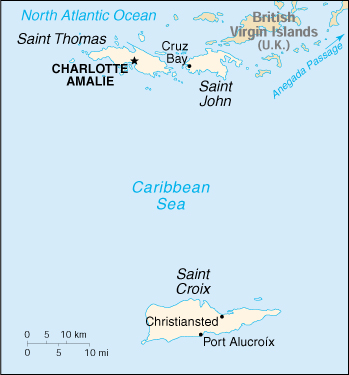| The
Virgin Islands of the United States (pop.121,000 in 2000), 133
sq mi (344 sq km), are a U.S. territory. During the 17th century,
the archipelago was divided into two territorial units, one
English and the other Danish. The U.S. purchased the Danish
territory in 1917 for $25 million because of the strategic position
in the Angenda Passage, a key shipping lane to the Panama Canal.
Unincorporated territory of the US with policy relations between
the Virgin Islands and the US under the jurisdiction of the
Office of Insular Affairs, US Department of the Interior. A
governor and senate are locally elected. Since 1927, residents
have enjoyed U.S. citizenship, and since 1973 they have been
represented in the U.S. House of Representatives by a nonvoting
delegate. Although 68 islands comprise the group, only the three
largest—St. Croix (80 sq mi/207 sq km), St. Thomas (32 sq mi/83
sq km), and St. John (20 sq mi/52 sq km)—are of importance.
Saint Thomas has one of the best natural, deepwater harbors
in the Caribbean. Sugarcane, produced by slave labor, drove
the islands' economy during the 18th and early 19th centuries.
Tourism is the primary economic activity, accounting for more
than 70% of GDP and 70% of employment. The islands normally
host 2 million visitors a year. The manufacturing sector consists
of petroleum refining, textile, electronics, pharmaceutical,
and watch assembly plants. The agricultural sector is small,
with most food being imported. International business and financial
services are a small but growing component of the economy. One
of the world's largest petroleum refineries is at Saint Croix.
The islands are subject to substantial damage from storms.
Die
Virgin Island der Vereinigten Staaten (Bevölkerung 2000:
ca. 121.000), 344 Quadratkilometer, sind ein US Territorium.
Im 17. Jahrhundert wurde die Inselgruppe in zwei Teile geteilt,
einem englischen und einem dänischen. Die Vereinigten Staaten
kauften 1917 den dänischen Teil für eine Summe von
25 Millionen Dollar. Der Grund war die strategische Lage in
der Angenda Passage, einem der Hauptzufahrtsrouten zum Panamakanal.
Nicht angebundenes Territorium der USA. Das Verhältniss
zwischen den Virgin Islands und der USA unterliegen dem Office
of Insular Affairs des US-Innenministerium. Ein Gouverneur und
ein Senator werden vor Ort gewählt. Seit 1927 besitzen
die Einwohner die amerikanische Staatsangehörigkeit. Seit
1973 werden sie im House of Representatives durch einen Vertreter
ohne Wahlrecht vertreten. Obwohl die Inselgruppe aus 68 Inseln
besteht, haben nur die drei größten eine Bedeutung
- St. Croix (80 sq mi/207 sq km), St. Thomas (32 sq mi/83 sq
km) und St. John (20 sq mi/52 sq km). Saint Thomas hat einen
der besten natürlichen Tiefwasserhäfen in der Karibik.
Zuckerrohr, mit Sklavenarbeit bearbeitet, trieb die Wirtschaft
im 18. und im frühen 19. Jahrhundert an. Heute stellt der
Tourismus mit einem Anteil von mehr als 70% des Bruttoinlandsproduktes
die Haupteinnahmequelle der Inseln dar und ist Grundlage von
mehr als 70% der Arbeitsplätze. Die Insel empfängt
üblicherweise 2 Millionen Besucher pro Jahr. Der herstellende
Sektor setzt sich aus Öraffinerien, Textilien, Elektronik
und Uhrenherstellung zusammen. Der landwirtschaftliche Sektor
ist klein, und die meisten Lebensmittel müssen importiert
werden. Internationale Unternehmens- und Finanzdienstleistungen
sind ein noch kleiner, aber wachsender Teil der Wirtschaft.
Eine der größten Petrolieumraffinerien steht in Saint
Croix. Die Inseln werden oft stark von Stürmen beschädigt.
GOVERNMENT
Country name (conventional long form): United
States Virgin Islands
Capital: Charlotte Amalie
House of Representatives: Congressional
Delegate
STATISTICS
Population (July 2007 est): 108,488; Population growth rate: -0.171% (2007 est.)
Land Area: 133 sq mi (344 sq km)
ECONOMY
GDP: purchasing power parity - $1.577 billion
(2004 est.)
Agriculture: Fruit, vegetables, sorghu, Senepol cattle
Industry: Tourism, petroleum refining, watch assembly,
rum distilling, construction, pharmaceuticals, textiles, electronics
|



